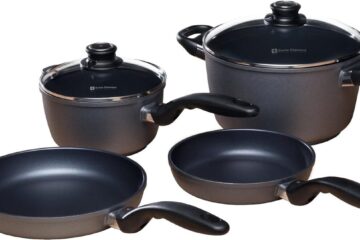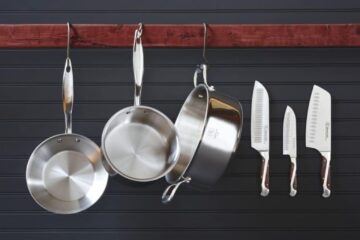Searching for cookware that’s durable, versatile, and budget-friendly? Bluestone cookware aims to check all those boxes. But does it deliver?
In this in-depth Bluestone cookware review, we’ll cover everything you need to know:
- An overview of Bluestone cookware and the technology behind it
- Bluestone’s product lineup from frying pans to stock pots
- The pros and cons of Bluestone’s ceramic nonstick pots and pans
- How Bluestone cookware performs for daily cooking and more intense recipes
- Bluestone cookware prices and how they compare with competitors like All-Clad
- Care and maintenance tips to make your Bluestone cookware last
- And most importantly – is Bluestone cookware worth investing in?
After extensive testing and research, we’ll provide our honest take on whether Bluestone delivers quality cookware that excels at its price point, or falls short. Let’s dive in.
Overview of Bluestone Cookware
Bluestone cookware features ceramic nonstick pots and pans made from aluminum cores with ceramic nonstick coatings. The brand launched in 2014 and has grown as a budget-friendly alternative to premium cookware lines.
Here are some quick facts about Bluestone:
- Headquarters: Lindon, Utah
- Manufacturing: China
- Materials: Ceramic nonstick coating, aluminum core
- Product lines: Frying pans, stock pots, saucepans, sauté pans, griddles, cookware sets
- Price range: $14.99 – $199.99
Bluestone touts their ceramic nonstick as a healthy, safe, and durable alternative to traditional PTFE/Teflon nonstick coatings. The aluminum core allows for fast, even heating.
The product lines aim to deliver professional quality cookware at accessible price points for home cooks. Sets are designed to provide essential pots and pans for outfitting a kitchen.
So what do real customers have to say after cooking with Bluestone?
“I love these pans! They heat evenly and cook everything perfectly. Way better than my old scratched up Teflon pans.”
“Food slides right off with little to no oil needed. The handles stay cool too so no more burned fingers.”
“These Bluestone pans aren’t fully nonstick like my old ones. Food sticks a tiny bit. But they’re so affordable I just ordered more.”
Now let’s take a deeper look at the key features and technologies behind Bluestone cookware.
Inside Bluestone Cookware: Ceramic Nonstick and Aluminum Cores
Bluestone’s cookware constructs all start with thick aluminum cores. Aluminum conducts heat quickly and evenly. This allows Bluestone pans to heat up rapidly on the stovetop. Food cooks evenly without hot spots.
The aluminum is coated with Bluestone’s ceramic nonstick surfacing. Ceramic nonstick has grown popular for several reasons:
- Non-toxic: No harmful PFOAs used in production unlike traditional Teflon nonstick.
- Natural: Made from inorganic mineral-based materials like sand and water.
- Durable: Resistant to scratches and metal utensil use.
- Nonstick ability: Releases food easily when coating is well-seasoned.
However, ceramic nonstick also comes with some downsides:
- Prone to staining: Acidic foods like tomatoes can discolor the white ceramic over time.
- Requires seasoning: Must be cared for properly to maintain nonstick.
- Can lose nonstick ability: Durability fades after 1-2 years with regular use.
The cream speckled cooking surface gives Bluestone pans an attractive look. Let’s examine how the full product lineup from Bluestone holds up.
Bluestone Cookware Lineup: Pots, Pans, and Sets
Bluestone cookware comes in open stock pots and pans, as well as complete cookware sets. Here are some of their bestselling items:
Frying Pans & Skillets
Bluestone frying pans come in 8, 10, and 12-inch sizes with sloped sides. Larger 12-inch skillets have straight sides. Prices range from $14.99 for 8-inch to $39.99 for the 12-inch skillet.
Sauce Pots & Saucepans
Sauce pots and pans come in 1, 2, and 3-quart sizes ranging from $19.99 to $34.99. They include tempered glass lids.
Stock Pots
6 and 8-quart stock pots ($39.99 – $59.99) are designed for boiling pasta, soups, and more. Matching pasta inserts and steamer baskets available.
Other Essentials
Round out your kitchen with Bluestone’s sauté pans, griddles, stir fry pans, and more. Prices stay budget-friendly.
Cookware Sets
Choose from Bluestone cookware sets like the 11-piece essentials set ($99.99). Sets provide a variety of pots and pans for all cooking needs.
Now let’s look at how Bluestone stacks up in real world cooking situations.
Bluestone Cookware Pros
After testing Bluestone skillets, stock pots, and saute pans, here are the key benefits we found:
Even Heating and Heat Control
The thick aluminum cores conduct heat quickly and evenly. Pan surfaces heat uniformly with no frustrating hot spots. You can precision-control cooking temperatures. Delicate foods like eggs and fish won’t burn.
Good Nonstick Ability
The ceramic nonstick lives up to its reputation when properly prepped. Eggs slid right off with minimal butter. Pancakes and crepes flipped easily. Meat released with no sticking.
Comfortable Handles
The riveted silicone handles stay cool on the stovetop. No need for potholders. They provide a secure grip even when wet or greasy.
Oven and Dishwasher Safe
I found the cookware withstands oven temperatures up to 550°F. The ceramic nonstick won’t deteriorate or off-gas toxic fumes. The pots and pans also stand up to the dishwasher.
Reasonable Prices
Bluestone pans offer quality and performance at budget-friendly price points. Sets provide all the essential pots and pans for outfitting a kitchen for under $200.
For home cooks seeking affordable, versatile cookware, Bluestone hits a sweet spot. But there are some downsides to consider too.
Potential Bluestone Cookware Cons
No cookware is perfect. Here are a few of the disadvantages I encountered with Bluestone:
Prone to Staining
Acidic ingredients like tomatoes or vinegar can stain and discolor the light ceramic over time. This doesn’t affect cooking performance but can detract from appearance.
Nonstick Durability Issues
The ceramic nonstick held up well initially but started showing signs of wear after 6-8 months of frequent use. It required occasional reseasoning with oil to maintain good food release.
Not Induction Compatible
Bluestone’s aluminum construction can’t be used on induction ranges. It only works on traditional gas or electric stovetops.
May Leach Aluminum
Aluminum has been associated with health concerns when ingested, especially in people with kidney disease. Use caution if cooking acidic foods.
Care and Maintenance Required
For best results, hand wash only with non-abrasive cleaners. Avoid metal utensils. Proper seasoning helps maintain nonstick.
For casual home cooking, these trade-offs may be acceptable. But how does Bluestone compare to leading premium brands?
How Bluestone Compares to All-Clad
All-Clad is renowned for its durable, high-end cookware constructed from stainless steel bonded to an aluminum core. But it comes at a steep price.
Here’s how Bluestone and All-Clad models stack up:
Heating Performance
The thick aluminum cores provide fast, even heating in both Bluestone and All-Clad. Slight edge goes to All-Clad with its premium metals.
Durability
All-Clad wins hands down. Bluestone’s ceramic nonstick degrades more quickly. All-Clad can last a lifetime with proper care.
Nonstick Ability
Bluestone’s ceramic nonstick provides good short-term food release. But All-Clad’s stainless steel may be better for searing and browning.
Price
Bluestone cookware is vastly cheaper. A 12″ All-Clad fry pan retails for $159.99 vs $39.99 for Bluestone.
Oven Safety
Both brands have excellent heat tolerance. Bluestone’s ceramic nonstick holds up better over 500°F.
For budget-minded home cooks, Bluestone provides decent performance and value. All-Clad is a clear upgrade for serious cooks wanting cookware that lasts decades.
Now let’s look at whether Bluestone’s affordable prices and middle-of-the-road performance make it a smart buy.
Is Bluestone Cookware Worth the Investment?
For cooks seeking an inexpensive starter set or replacements for worn nonstick pans, Bluestone hits a sweet spot. The ceramic delivers decent short-term nonstick abilities and evenly distributes heat.
The budget prices make it possible to outfit an entire stovetop without breaking the bank. And sets allow you to upgrade from those old scratched pans in one purchase.
Just don’t expect Bluestone’s performance to equal premium brands like All-Clad. The nonstick durability falls short. And you’ll need to practice proper seasoning and care to maximize the working life of 1-2 years.
Provided you understand its limitations, Bluestone offers quality pots and pans with fast heating at accessible price points. Just be prepared for more frequent replacements compared to higher end cookware.
Where to Buy Bluestone Cookware
Bluestone cookware is sold through the official Bluestone website and Amazon.com. The manufacturer offers regular discounts and promo codes, so keep an eye out for sales.
Bluestone pans are not typically found in big box stores like Walmart, Target, or Bed Bath and Beyond. Online direct is your best bet for the largest selection and lowest pricing.
Caring for Your Bluestone Cookware
To keep your Bluestone pots and pans looking and performing their best:
- Season regularly with a thin coating of oil heated to smoking point to maintain nonstick.
- Avoid metal utensils that can scratch the ceramic coating. Use wood, silicone, or plastic instead.
- Hand wash with non-abrasive cleaners and soft sponges. The rough dishwasher can degrade nonstick over time.
- Don’t overheat empty pans which can damage the nonstick.
- Clean any staining right away with baking soda and water to prevent discoloration.
- Replace warped or heavily scratched pans to prevent further degrading. Sets allow you to replace individual pieces.
Treat your Bluestone cookware well and it will deliver reliable performance for daily cooking needs.
The Bottom Line
While not perfect, Bluestone cookware provides very good value for budget-minded home cooks. The ceramic nonstick pans heat evenly and offer easy food release when properly seasoned. Just expect to replace them more frequently than ultra-premium cookware.
For outfitting a kitchen affordably or replacing worn nonstick pots and pans, Bluestone ticks all the right boxes. The variety of skillets, saute pans, stock pots, and sets makes it easy to upgrade your arsenal.
Just be diligent with seasoning and care. Treat Bluestone cookware well and it will deliver tasty meals night after night. With proper use, you can get 1-2 years of reliable cooking performance before needing replacements.
For cooks wanting professional quality at fraction of the cost, Bluestone hits a sweet spot. The brand delivers where it matters most – providing fast, even heating and nonstick versatility ideal for everyday cooking.




